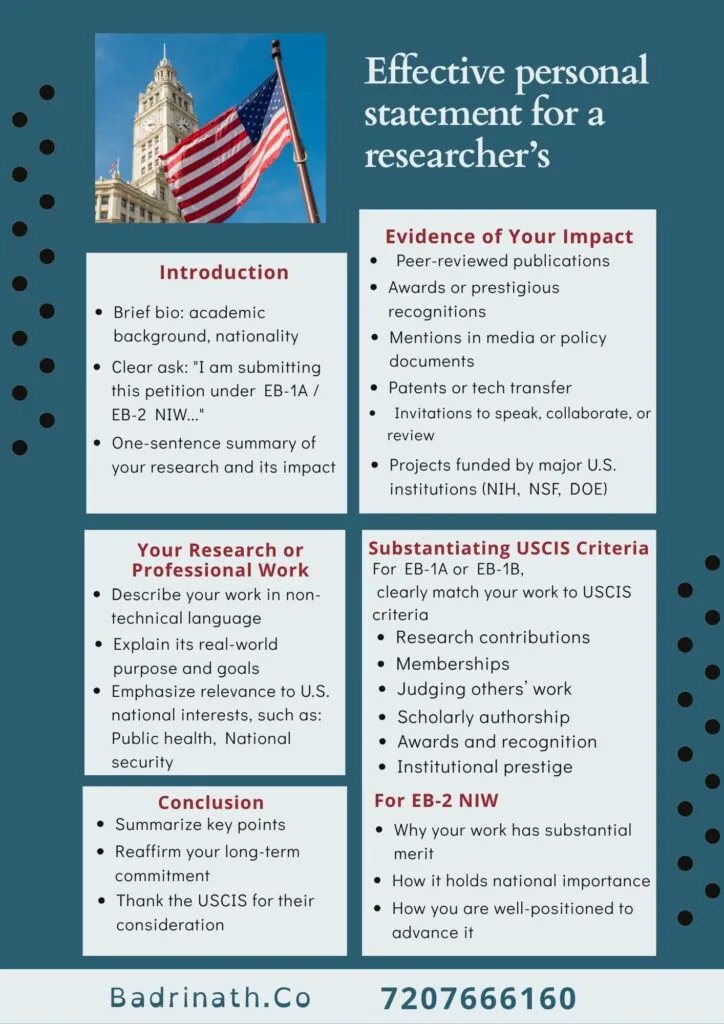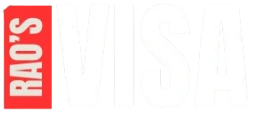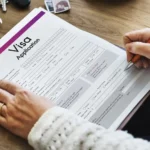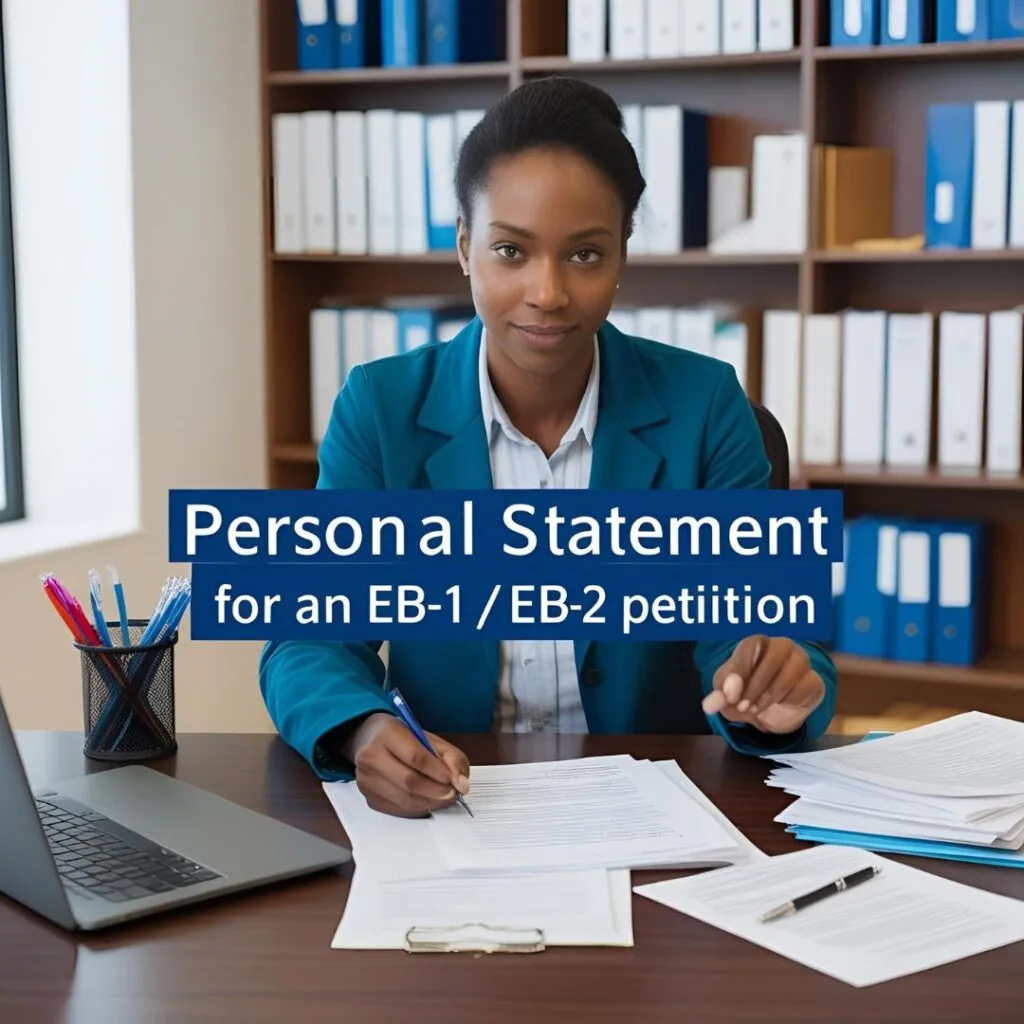The Critical Role of Your Personal Statement for EB-1/EB-2 Petition
EB-1/EB-2 Petition is a pivotal document in your personal statement. Unlike other supporting documents that demonstrate your achievements through third-party evidence, the personal statement offers you the unique opportunity to directly address USCIS officers, contextualizing your accomplishments and articulating your future contributions to the United States. A compelling personal statement can significantly strengthen your case by creating a coherent narrative that ties together all elements of your petition.

Strategic Formatting and Structure for EB-1/EB-2 Petition
Professional Presentation
- Include the current date at the top of the document
- Begin with a formal salutation (e.g., “Dear USCIS Officer” or “To Whom It May Concern”)
- Include a clear subject line: “Personal Statement – [Your Full Name]”
- End with your full name and signature in ink
Optimal Length and Organization
- Aim for 2-4 pages (approximately 1,000-2,000 words)
- Use clear section headings to improve readability
- Ensure consistent formatting throughout (font, margins, spacing)
- Number pages if the document exceeds two pages
Essential Content Components for EB-1/EB-2 Petition
1. Comprehensive Academic and Professional Background (25-30% of document)
- Begin with a concise overview of your educational credentials and career trajectory
- Highlight pivotal moments in your professional development that demonstrate progression
- Emphasize positions of leadership or significant responsibility
- Detail specialized training, fellowships, or prestigious appointments
- Connect your background directly to your field of expertise
2. Significant Research Contributions and Recognition (30-35%)
- Articulate your most significant research findings and innovations
- Explain how your work has advanced knowledge in your field
- Detail the practical applications or implications of your research
Document international recognition through metrics:Publication record in high-impact, peer-reviewed journals - Citation statistics that demonstrate influence
- Conference presentations, particularly invited talks
- Patents or commercially valuable intellectual property
- Research grants and competitive funding secured
- Editorial positions, peer review activities, or other field service
3. Future Research Agenda and U.S. Contributions (35-40%)
- Outline your specific research plans and projects for the next 3-5 years
- Explain why the United States is the optimal environment for your work
- Detail potential collaborations with U.S. institutions, researchers, or industries
- Describe anticipated outcomes and deliverables of your future work
Explicitly connect your research agenda to:U.S. economic interests (job creation, innovation, competitive advantage) - U.S. public health or safety improvements
- U.S. educational or scientific advancement and also
- Other national priorities (energy security, environmental protection, etc.)
Strategic Writing Approaches
Evidence-Based Assertions
- Support every claim about your qualifications with specific evidence
- Reference documentation included elsewhere in your petition package
- Use precise metrics and statistics rather than general statements
- Cite external validation of your work from recognized authorities
- Finally reference any collaborations with prestigious U.S. institutions
Technical Precision with Accessibility for EB-1/EB-2 Petition
- Demonstrate your expertise through appropriate technical language
- Provide clear explanations for complex concepts
- Assume the USCIS officer is educated but not a specialist in your field
- Define field-specific terminology when necessary
- Use analogies to explain complex research when appropriate
Addressing Statutory Criteria Without Explicit Listing
- Weave evidence of meeting the regulatory criteria throughout your narrative and also
- For EB-1, subtly address the “international recognition” standard
For EB-2 NIW, emphasize elements that satisfy the Dhanasar framework:
Substantial merit and national importance of your work
- Your well-positioning to advance the proposed endeavor and also
- National interest benefits of waiving the job offer requirement
Common Pitfalls to Avoid
Content Missteps
- Being overly modest about achievements (this is not the time for humility)
- Including irrelevant personal information or lengthy biographical details
- Failing to distinguish between your contributions and those of collaborators
- Making unsupported claims about your significance in the field and also
- Underemphasizing practical applications or real-world impact of your work
Stylistic Weaknesses
- Using overly technical jargon without necessary context
- Writing in a disjointed manner that fails to create a cohesive narrative
- Employing hyperbole or subjective self-praise rather than objective evidence
- Including lengthy, unbroken paragraphs that reduce readability
- Grammatical errors, typos, or inconsistent formatting
Writing Process Recommendations
Firstly ensure consistency with other petition documents
Secondly Begin by outlining all key points you need to address
Draft each section separately, focusing on clear communication
Revise for coherence, ensuring your narrative flows logically
Edit for concision, removing redundancies and unnecessary details
Proofread meticulously for grammar, spelling, and formatting issues
Finally have colleagues review for clarity and persuasiveness

Conclusion
Your personal statement should serve as the narrative thread that weaves together all components of your petition. When well-crafted, it helps USCIS officers understand not only what you have accomplished but why those accomplishments matter—both to your field and to the United States. By clearly articulating your exceptional abilities and future contributions, you create a compelling case for approval of your petition and permanent residence in the United States.
Keywords:
- EB-1/EB-2 Petition personal statement
- EB-2 NIW personal statement
- Green card for researchers
- EB-1A petition writing
- EB-1/EB-2 Petition statement tips
- Writing personal statement USCIS
- Researcher green card USA
- National interest waiver statement
Read More About the Topic
External Links
EB-1-2 OUTSTANDING RESEARCHER CASES
EB-1 Outstanding Professors or Researchers
Internal Links
Timeline Differences Between EB-1 and EB-2 NIW
Building Your Case: List of Documents Needed for EB-1A, EB-1B, and EB-2 NIW







